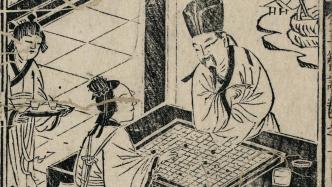
"But it is the person who lives in the east of Pu County in the late spring. In the Xiao Temple, the door is heavily closed, the flowers are falling and the water is red. There are thousands of idle sorrows, and I have no words to complain about the east wind."
Cui Yingying in "The Romance of the West Chamber" saw the flowers falling and the water running red. In her youth, there were flowers falling and the water running red, so she felt that she was full of sorrow and could only blame the east wind.
In the late Ming Dynasty, engraved books flooded into people's lives in large numbers. Various types of books with pictures and texts could enrich people's lives in their spare time. Although books in the late Ming Dynasty were not as popular and developed as they are now, to a certain extent, the depth and breadth of their circulation among the middle and upper classes was enough to create a peak in the history of book development. Different workshops, different painters, and different engravers have produced completely different types of book engravings. While paintings and books are integrated, art has also been continuously sublimated through repeated printing and spreading over the times. Among them, the most outstanding representatives are opera engravings.

origin
Between Geng Yin and Xin Mao, I visited Cambridge, Massachusetts. The country was far away, it was snowing suddenly and the nights were cold. I read a little bit in boredom, and the notes and books I accumulated turned out to be two thick volumes and dozens of gigabytes of hard drives. At that time, we focused on some issues in depth and formed several articles. The title of the play was "Yan Yun's Reading Notes", which was published in "New Art". After reading it, some teachers and friends thought that my writing style was slightly improved compared to my previous style of writing, which favored macro narratives and empty discussions. I also felt that this kind of "note style" was very suitable for basic work on images and documents in the history of printmaking, so I decided to continue doing it. Go down. At the turn of the year, I picked up my doctoral thesis that I had put away for a long time and vowed to revise it. I did not dare to "do less work without regrets". I made many historical facts and based on my notes from my trip to the United States. superior. Because I know that although the notes are scattered and disorderly, they may not be unable to inspire research and write new chapters in the future. This time I compiled "The Essence of Ancient Chinese Opera Prints". After finishing the draft, I felt that I was still not finished, so I compiled and transcribed the notes I had made over the past ten years and attached them to the end of each volume. This book is precious and contains only a few old news. It has many sloppy thoughts and unclear meanings, and it has not been given detailed annotations. It cannot be regarded as a thesis. It is nothing more than an accumulation of winter baking and unskilled carving for the entertainment of the Fang family.
"True Notes of the Supplementary Meeting"
In the third year of Longqing's reign (AD 1569), Gu Xuanwei of Zhongfang's Study House in Suzhou had an engraving of "Additional Records of Huizhen", and Zheng Zhenduo's "A Brief History of Ancient Chinese Woodcuts" recorded it as "Miscellaneous Records of the West Chamber". This name has been used in the history of printmaking. In fact, the preface and table of contents of this book are all titled "Additional Records of Huizhen", the front volume and the center of the page are engraved with "Records of Collector Huizhen", and the title of the second volume is "Miscellaneous Records of Addendum of Huizhen", so-called This is the origin of "Miscellaneous Records of the West Chamber" and is not the title of the original book. Wang Jide ranked Gu Xuanwei's edition alongside Xu Shi's model edition and Jin Zaiheng's edition, and accepted it as an early rare edition of "West Chamber". The "Miscellaneous Records" currently stored are the appendices to Gu Xuanwei's edition. "Supplementary Huizhen Ji" has four illustrations. Among them, "Song Ben Huizhen Picture" is a song picture, which depicts Zhang Sheng and Yingying interacting across the wall. The depiction is poor. According to Zheng Zhenduo's words, it is "extremely clumsy, rough and spicy." Another painting, "Picture of the West Chamber of Pujiu Temple in Hezhong", is similar to a map, with Gu Xuanwei's inscription on it. Before that, there were two frames of "Portrait of Yingying", one was inscribed "The True Yingying of Cui of the Tang Dynasty" and signed "Written by Chen Juzhong of the Painting Academy of the Song Dynasty", the other was inscribed "The Yingying's Beauty" and signed "Copy of the Yingying of the Tang Dynasty by Wu Chi". ". Judging from the styling and brushwork of these two pictures, they surpass the naive and rough styles of print illustrations of the same period. They are peaceful and elegant, and can be called masterpieces. More importantly, Xidi believed that these two works were the first to see the Yingying image in a publication. They could be said to be the "ancestors" that pioneered the trend and had a profound influence on later generations. Those who carved "West Chamber" in the late Ming Dynasty either borrowed them directly or slightly processed them, so that these two "portraits of Yingying" appeared frequently in the front volumes of different editions of "The Romance of the West Chamber".
In the history of printmaking by ancient people, every time these two images are derived from the original works of Chen Juzhong and Tang Yin, it is not only contrary to the history of painting, but also contrary to common sense, so it can be criticized. Reading the original book of "Supplementary Huizhen Ji", Gu Xuanwei postscripted "Tang Cui Yingying Zhen": "At the age of Ding Youyu, he tried to test the Nanjing Zhao. At that time, the Wen family in the neighboring museum had a statue of Yingying for sale, and the crowd was crowded. It depicts Master Judu of the Northern Song Dynasty. , the color is bright and clear, the body is more than two feet long, and the plump gourd is as beautiful as a man. Maybe the clouds came out of Wuyuan Linben, but the rope was too high, so he actually took the bag away. When examining Cui's image, the painting records do not record the dynasty of the painting. , is it the porridge evil in the city? What is the original evil of Chen Bie? Chen Yijiatai Nengpin wrote in the "Baojian" for his records, "He was not convinced that the "Yingying Statue" he saw in Nanjing in the past was really the handiwork of Chen Juzhong. There is no theory that it was used as a basis for printing prints; there is also a postscript in "Yingying Yiyan" that says: "Yingzhao's old collection was in the Jin Mausoleum and Chiang Kai-shek's Ministry. I borrowed it for three days and couldn't get it. How can it be that his surname is evil? I will copy it again and Gu Xu will praise it for the painting." He bluntly said that he had never seen this painting before. Obviously, the two prints engraved in "Supplementary Huizhenji" were just made by Gu's painter based on his own admiration and imagination. Printmaking in the late Ming Dynasty pretended to be famous, and both the calligraphers and readers at that time tacitly understood and enjoyed the fashion and interest conveyed in it. On the contrary, some commentators today do not know the truth, talk about the extensive participation of famous artists in the creation of prints, and make a lot of useless research, which is regrettable.
Fuchundang's version of "Ten Righteousnesses"
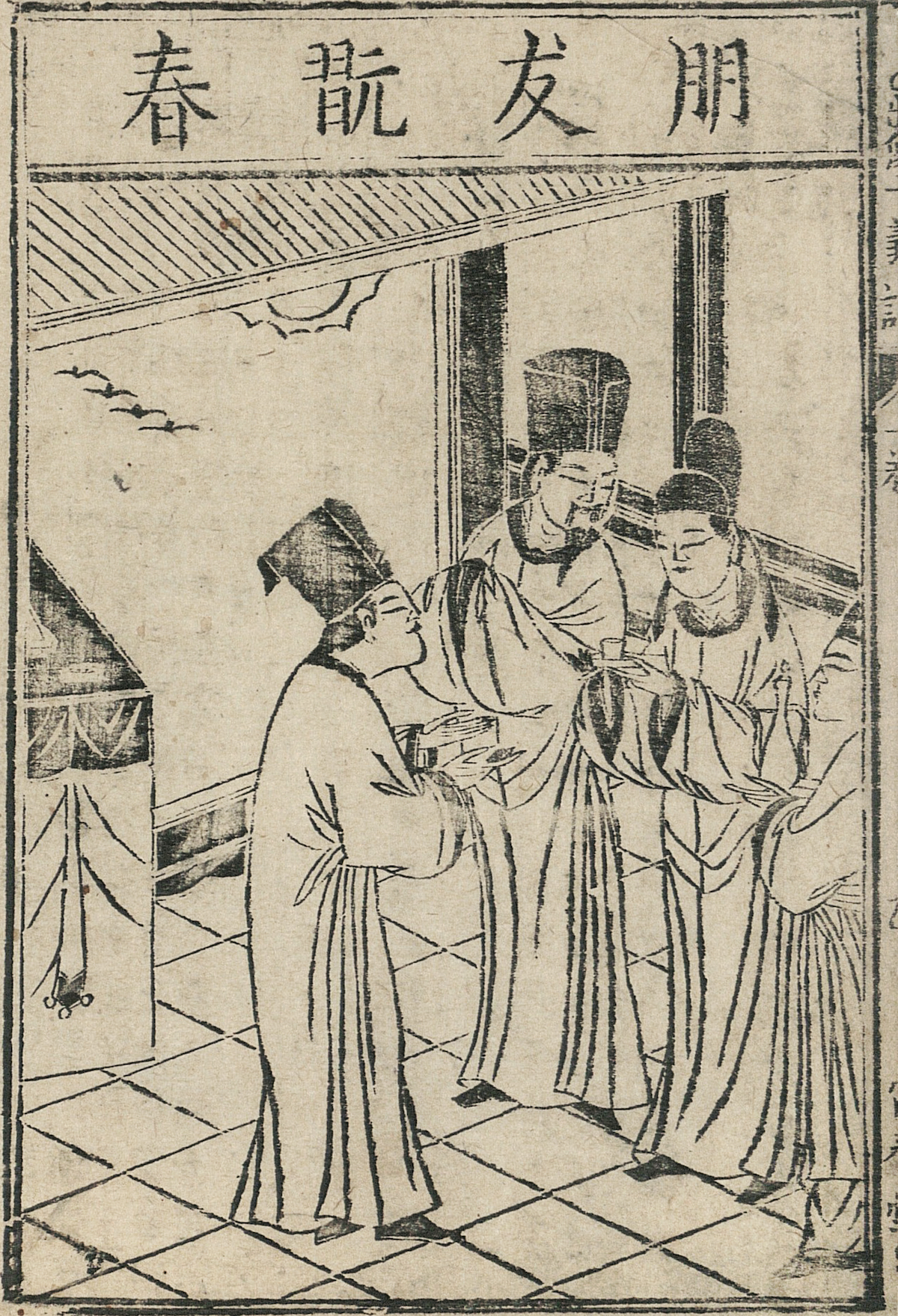
Records of the Ten Righteousnesses, engraved edition of Fuchun Hall in Nanjing during the Wanli period of the Ming Dynasty, collected by the Taiwan Library
The title of "New Issue Sound Releases Like Han Peng Shi Yi Ji" is a typical Fuchundang song version: the layout is very crowded, with "phonetic notes" sandwiched between the lines, which is already messy, and it is even decorated with flower frames around it. increase interference. The handwriting is clumsy, the size is uneven, and there are many typos. It can be judged that it was made by a cheap copywriter. As for its prints, they are consistent with the overall level of the song: the modeling ability is generally poor, the characters are not only crude, but often distorted and deformed; the composition is also primitive, and can often only highlight the activities of the characters in the plot. The description of the scene is still at a slightly schematic stage, and some formulas do not deviate from the simulation of stage scheduling and scenery. The carving technique is blunt and blunt, with few details expressed, and the treatment of clothing grains is particularly hasty and messy. In many places, large black ink blocks are used to replace complicated line drawings.
Fuchundang's version of "San Yuan Ji"

The Three Yuan Chronicles, a printed copy of Fuchun Hall in Nanjing during the Wanli period of the Ming Dynasty, collected by the Taiwan Library
"New Carvings of Xiangyin Annotated Shang Lu Sanyuan Ji" and "Shi Yi Ji" are both Yiyang tunes written by Anonymous, and the style and level of the prints are also roughly similar. The first volume of this volume is signed "Jinling Shufang Fuchun Hall Zi"; the first volume of "Shi Yi Ji" is inscribed "Jinling Duixi Tang Fuchun Zi Xing"; "Guanyuan Ji" is signed "Jinling Tang Fuchun Tang Zi Xing". In the 32nd year of Wanli (AD 1604), the front volume of the "New Compilation of Ancient and Modern Shi Wen Classifications" was signed "Reprinted in the Preface of Shi Wen Classifications" with the words "Shi Wanli Jiachen Meng Chun Zhi Ji Jinxi Tang Fuchun Fine Collation Addendum Reprinted" , the title of the volume is "Jinling Tang Fuchunzi Hejian", and the center of the page is inscribed "Deshou Tangzi". Knowing that the owner of Fuchundang was named "Tang Fuchun" and also had the names of "Zihe" and "Duixi", he later published the tune under the name of "Deshou Tang", and the style was completely different from that produced by Fuchundang. The similarity can be proved by the second volume of this book, "Huan Sha Ji".
Tang Fuchun's original place of origin is "Jinxi", which is Jinxi County, Fuzhou Prefecture, Jiangxi Province. Volume Three of Tongzhi's "Jinxi County Chronicle" "Geographical Chronicles: Capital Map" records that there are "fourteen lanes" in the county, the fourth of which is named "Fuchun Lane". There seems to be a connection between Tang Fuchun's name, the shop he opened in Nanjing, and the alleys of his hometown. Jinxi belongs to the Gan dialect area, which is the birthplace and popular area of Yiyang tune. Therefore, most of the existing tunes in Fuchuntang are Yiyang tune legends. This section has been concluded by scholar Ma Huaxiang. Generally speaking, Yiqiang works belong to the category of folk tunes and are often written by lower-class literati whose surnames are difficult to identify. At that time, the scenes of the Jin gentry and officials "paying attention to the music...and having the skills to perform the music", "the elegance is boiling, and the romance is concealed" and "the mountain of Quhai Ci is now fierce" has not yet appeared; the readers and audiences targeted by these operas must be Lower level "literate population". For buyers who have just begun to read and have limited understanding, the primary function of illustrations is indeed to explain the plot of the story to assist cognition, and to enable them to establish a memory or imagination of the stage performance. These two points are rich Spring Hall has done it all. As for the requirements for sophistication and elegance as a work of art, it goes beyond the ability of the "Fuben" publisher and the imagination of the "Fuben" consumers. This is generally the case not only in Nanjing, but also in the operas published in various places around the fifteenth year of Wanli (1587 AD).
Fuchundang's version of "Qin Xin Ji"
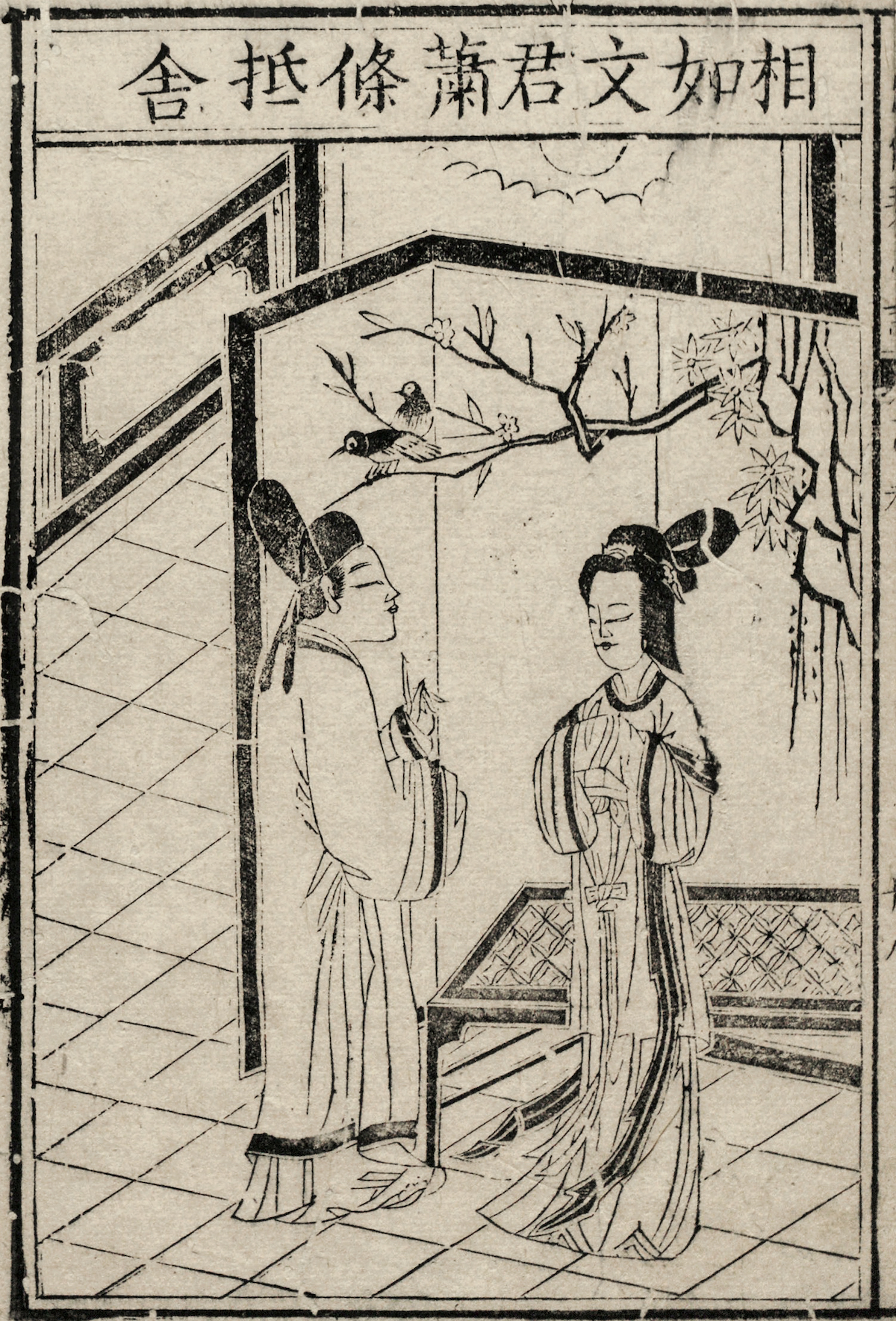
Qin Xin Ji, engraved version of Fuchun Hall in Nanjing during the Wanli period of the Ming Dynasty, [Japanese] Collection of the Cabinet Library
Among the tunes published by Fuchundang, there are also a few that clearly do not belong to the Yiyang tune system, such as "Jade Jue Ji" by Zheng Ruoyong, "Nanxixiang" by Li Rihua, etc. "Qin Xin Ji" written by Sun You of Yushan is also included in this list. This volume has a complete inner cover at the front, which is rare. The upper column is inscribed with "The Wanli Years of the Emperor Ming Dynasty", the left and right columns are inscribed with "Engraved Image Sound Annotation Sima Xiangru Qin Xin Ji", and the small inscription in the middle column is "Gusu". "Correcting the Embroidery Zipper of Jinling Fuchun Hall" shows that Tang Fuchun had felt the pressure of competition and tried to establish contact with literati writers, but was unable to do so. Although the prints of this book were more careful than those of "Shiyi" and "Sanyuan", they were still There is no "qualitative leap" without breaking away from the rough style.
Fuchundang's version of "Guanyuan Ji"
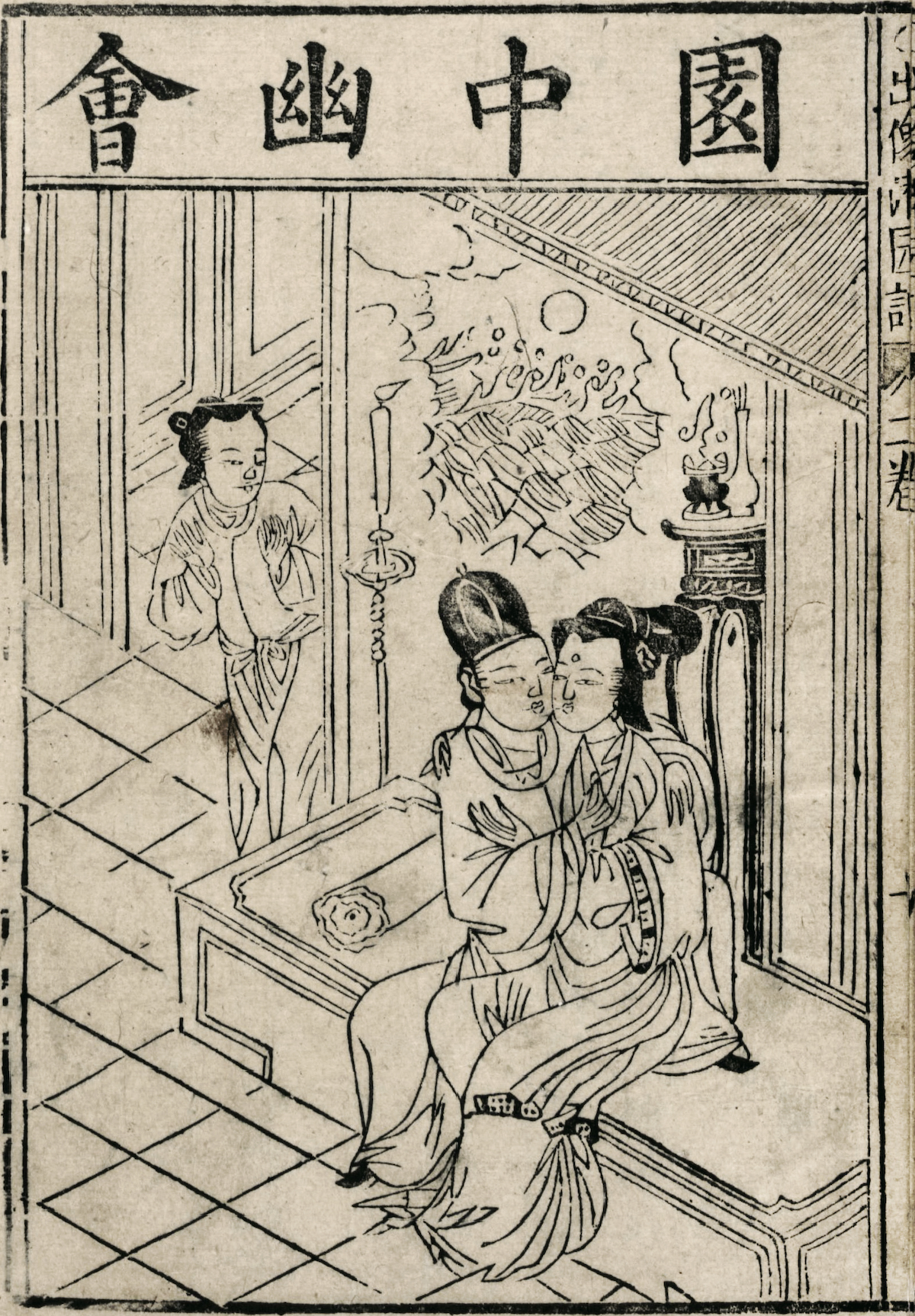
Garden Guanji, engraved version of Fuchun Hall in Nanjing during the Wanli period of the Ming Dynasty, collected by the Taiwan Library
Around the fifteenth year of Wanli (AD 1587), Fuchundang also published a series of "Tiger Talisman", "Zhufa Ji" and "Guanyuan Ji" by Zhang Fengyi, a famous scholar in Suzhou, which indicated a shift towards literary legends. However, judging from the actual results, Fuchuntang's efforts to adapt to the development trend of opera appear to be insufficient. The prints and engravings of the works published by Zhang Fengyi are extremely sloppy, the characters are severely deformed, and the sword techniques are overlapping and confusing, making them almost unrecognizable. The level is even far lower than many Yiyang tunes produced by Tongfang before. "Guanyuan Ji" is a type of painting, calligraphy, painting and engraving that can be classified as low-end. Here, I will select two paintings that are suitable for viewing and prepare one frame. The remaining paintings such as "Hou Shi Fa Zhang" should not have composition and shape. Those with low-end abilities can work casually and hurriedly. It is difficult to imagine that such a moment could be accepted by the authors and readers of literary legends. Zhang Fengyi traveled to Wen Taishi sect at an early age. He was good at calligraphy and good at connoisseurship. After that, Jizhizhai learned the new Huizhou style, first tested his skills with "The Story of Stolen Talisman", and then entered the good stage with "The Story of the Red Whisper", which must have something to do with Zhang's encouragement and even sponsorship.
Gao Shishanfang's version of "Mu Lian's play on saving his mother and admonishing good deeds"
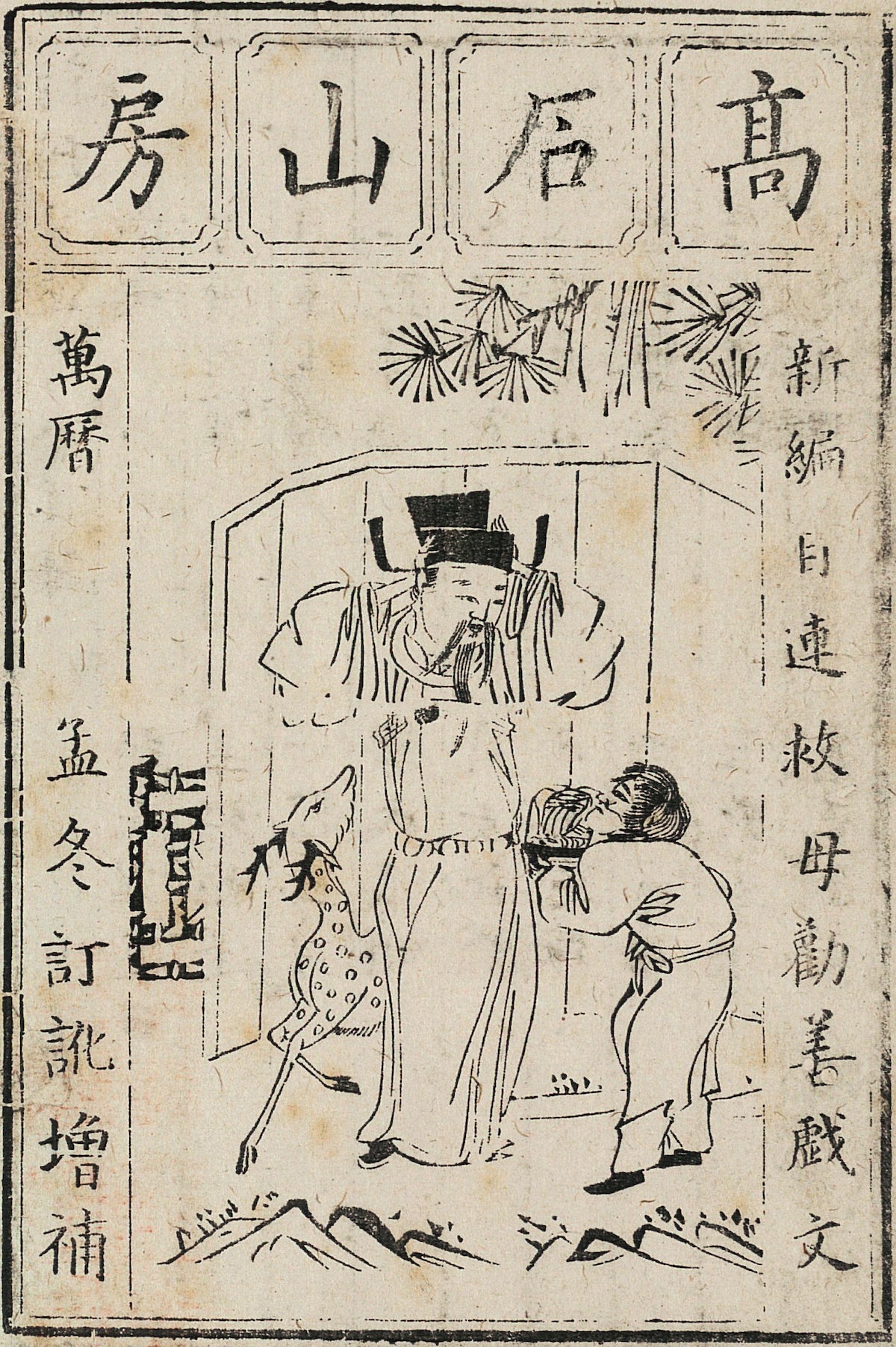
Mulian Saves His Mother and Encourages Good People to Operate Civilization. An engraving of Gaoshi Shanfang in Huizhou during the Wanli period of the Ming Dynasty. Collection of the Taiwan Library.
The original version of "Mu Lian's Story of Saving His Mother and Encouraging Good Deeds" published in "Gaoshi Shanfang" was roughly written in the eleventh year of Wanli (AD 1583) based on the preface to the volume. This book is published in the name of the author Zheng Zhizhen (a native of Gaoshishan), with a preface and postscript, which has the appearance of a literary work. Judging from the illustrations, they are similar to those of Fuchun Hall and Shide Hall in Nanjing Bookstore in the early Wanli period, and some of the shapes and compositions are even inferior to them. It is worth noting that this book should have been published in Huizhou, the hometown of the Zheng family, and the engraver, Huang Qing, was a senior member of the Huang family of engravers in Qiuchuan, who later became famous in the history of printmaking. At this time, it was still more than ten years before the great change in printmaking style from rough to refined in the middle period of Wanli Period.
"The Orphan of the Zhao Family" by Shi Detang
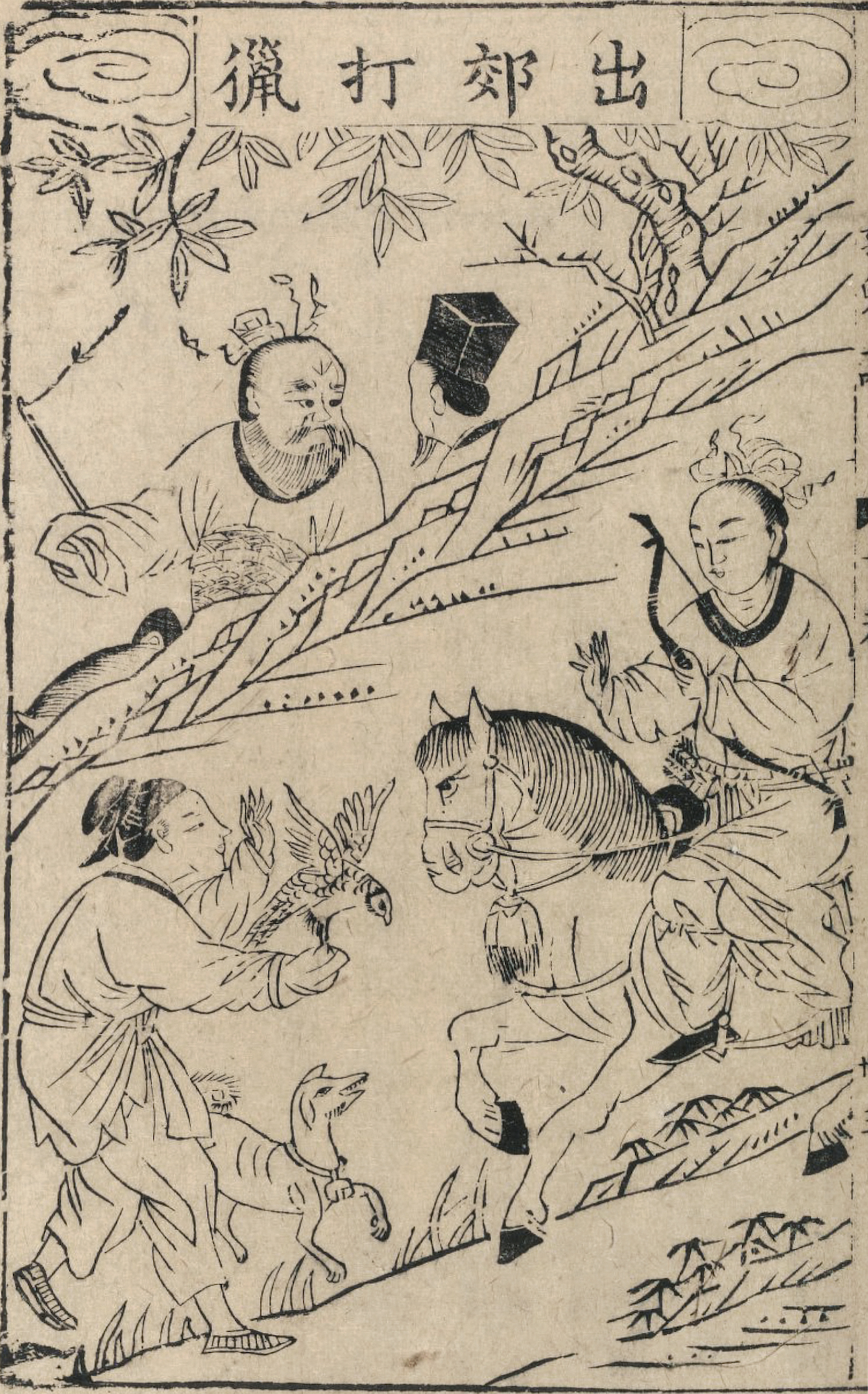
Chronicle of the Orphan of the Zhao family, engraved version of Shidetang, Nanjing during the Wanli period of the Ming Dynasty [American] Collection of Harvard-Yenching Library
Each copy of Shidetang's music is signed "Xiugu Tang Family". Check Tongzhi's "Jinxi County Chronicles" and Volume 2 "Geographical Chronicles: Mountains and Rivers": "Jinxiu Valley is in the city, and the county government relies on it as a barrier. From the hall, you can see the four mountains. The green mist and the thousands of tiles are different, and the scenery is gorgeous and looks like embroidery." Therefore, the person "Embroidered Valley" refers to is Jinxi, Fuzhou, Jiangxi. It can be seen that the owner of Shidetang also came from the Jinxi Tang family and was related to Tang Fuchun They should be from the same clan. The National Library of China has the "Newly Engraved, Re-edited and Annotated Pipa Ji", which has the same layout as the Shidetang music editions. The title of the volume is "Jinling Tang Sheng's Collection". The National Map also contains several engraved editions of "Tang Sheng". In addition to the unknown date of "Xin Ke Yi Jian Zhi", "Guan Lu" was engraved in the 41st year of Wanli (1613 AD), and "Xin Ke Yi Jian Zhi" was engraved in the 41st year of Wanli (AD 1613). "Answers to the Book of Songs" was engraved in the forty-seventh year of Wanli (AD 1619), which was very late. There is also an engraving of "Ear Tan Lei Zeng" in the 31st year of Wanli (AD 1603), with the title "Xiu Gu Tang Sheng Bocheng Tang Shu Yongzi" at the beginning of the volume. It is known that Tang Sheng's subtitles were Bocheng and Tang Shuyong, which may be the same. . The songs published by Shidetang still include some Yiyang opera legends, "The Orphan of Zhao" is one of them. There is also a Fuchundang version of "Zhao's Orphan". Comparing the two, it can be seen that the layout of the Shidetang version has changed greatly compared with the Fuchuntang version. The surrounding flower columns have been eliminated, the line spacing on each page has been increased, the fonts are neat and elegant, and the explanations have been moved to the eyebrow columns. , the content explained is also much more complicated. This format was later used by various music libraries in Nanjing for many years. Although the overall style of the "Shiben" prints is the same as that of the "Fuben" prints, the quality and appearance have been greatly improved, and some details have also been improved. The titles of the pictures are unified into four-character sentences, such as "Lights are forbidden in Shangyuan" and "Gongsun died". "section" and so on, and decorated with cirrus cloud patterns on both sides, which reflects the original requirement of pursuing refinement and decoration in songbook printing.
Shi Detang's version of "Returning Notes"

Also with a note, a engraved copy of Shidetang in Nanjing during the Wanli period of the Ming Dynasty, collected by the Taiwan Library
Compared with Fuchundang, Shidetang's prints are catching up from behind. This can be observed from the following three aspects: First, the figures in the paintings are relatively accurate, the clothing patterns are smooth and detailed, and the expressions and movements of the characters seem to echo each other. The meaning of looking forward is also reflected in the joys and sorrows of the characters; secondly, the environment and scenery can be consistent with the characters, and there is less clutter and randomness; thirdly, attention has been paid to the details, and the hats and crowns of the characters are not simply printed in ink. , and has a more complex depiction. The paintings selected in this volume, such as "Huadai Ji", "Zong Yishengfei" and "Capturing Yuanji alive", are all very vivid. Fuchundang prints rarely reach this level. However, from the perspective of the serious imbalance in the proportions of the characters in "The Lady Returns with Honor", the painter Shi Detang Yan was still a layman who was not really familiar with the principles of painting. It is worth noting that the title of the first volume of this volume is "The new publication has been re-edited with annotations and annotations for Pei Du Xiangshan. Xingyuan You's Xingxian Hall has re-edited the title of Tang's Shide Hall in Xiugu." "The re-edited dot plate also bears the original plate of Jizhizhai", which was added when Jizhizhai purchased its plates for reprinting after Shidetang closed down.
"The Story of the Jade Hairpin" by Shi Detang

The Story of the Jade Hairpin, engraved version of Shidetang, Nanjing during the Wanli Period of the Ming Dynasty, [Japanese] Collection of Kyoto University
This volume of "The Story of the Hosta" was once collected by the Japanese Naoki Kano, and is now owned by the Faculty of Literature of Kyoto University. The remaining catalog has reached the 15th fold. It is combined with the fragment of "The Story of the Red Fu" by Shitokudo. The front title page of the volume has Kano's inscription. . Starting around the fifteenth year of Wanli (1587 AD), more and more well-known literati actively joined in the creation of legends, a new trend emerged, and the era of Tang Xianzu and Shen Jing was coming. Shidetang's engraving of music is in such a period of inheriting the past and linking the future. Although the owner of Shidetang, like Tang Fuchun, came from Jinxi, Jiangxi, his collection of Yiyang tunes has been greatly reduced, and he has turned to many literary legends, such as the early work "The Incense Bag" and the famous drama "The Story of Yuhe" ""Hong Fu Ji" and so on, Gao Lian's "Jade Hairpin Ji" is also one of them. Among the previously selected volumes of Fuchundang, most of them show screens, which are mainly white screens with simple figures in between and do not form a picture. The screens in this volume show the consciousness of depicting the landscape of the literati. Although they are not perfect, they are no longer "rich". "This" is beyond its reach. Playing with this detail, you should observe the quiet and gradual changes in Nanjing's public atmosphere at that time.
Wanhuxuan version of "The Romance of the West Chamber"
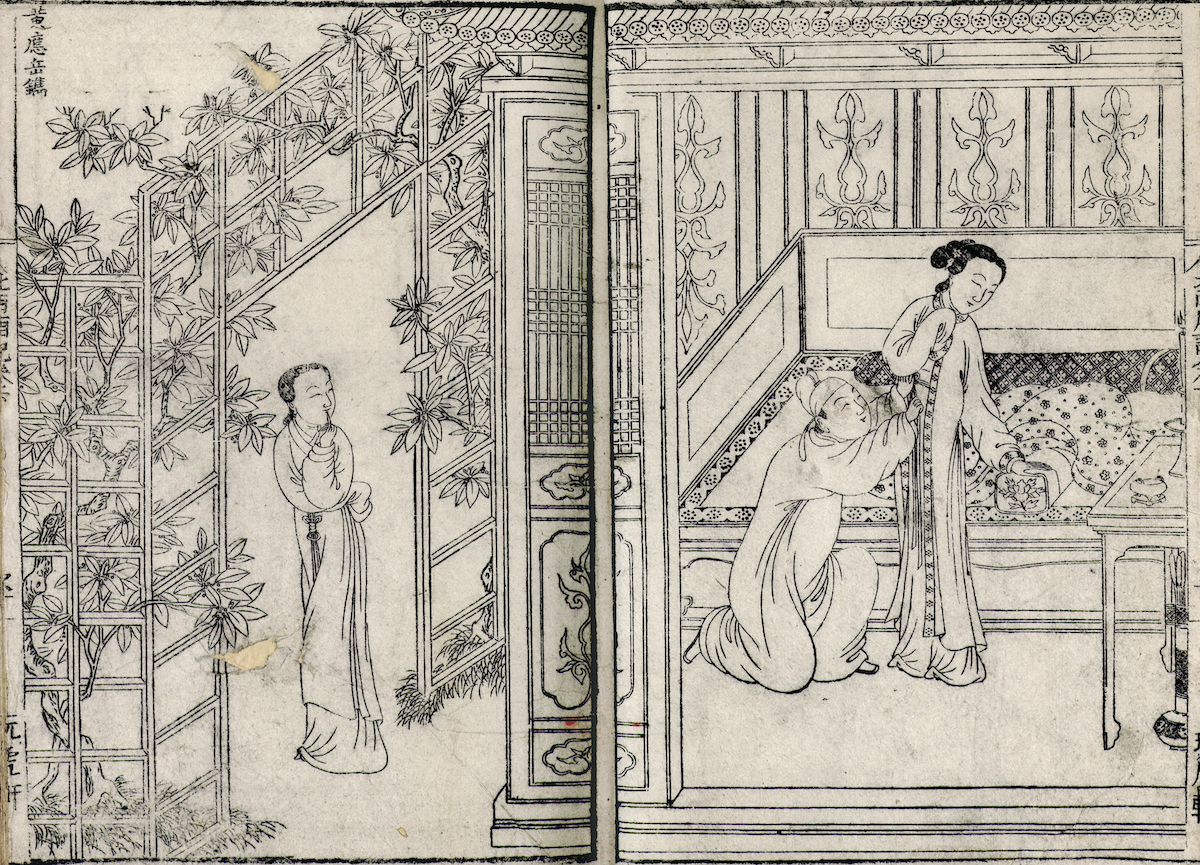
The Romance of the West Chamber, an engraving of Wanhuxuan in Huizhou during the Wanli period of the Ming Dynasty, collected by Anhui Museum
Wanhuxuan's version of "The Romance of the North West Chamber" is collected by the National Library as an appendix, and the illustrations are not included. The complete version is only found in Anhui Museum and has never been officially photocopied and made public. After many years of begging since Gengchen, Xin Chou was finally able to see the whole leopard a few days before the new Zhengzheng Festival, and he was granted permission by the museum to publish it for the enjoyment of his fellow travelers. The female historian Lu Yi from the Zhejiang Museum coordinated the matter and made this happen. She secretly said that her contribution to the "West Chamber" was great, although it could not be matched by the "Matchmaker". A smile.
In the twenty-fifth year of Wanli (AD 1597), Wanhuxuan republished Jiao Hong's "Yangzheng Illustrations" according to Wu Huairang's version. The engraving was done by Huang Qiyi of the "Wu version", and Huang Qiyi was the "Qiuchuan" "Huang Qi" is the 25th generation recorded in the "Huang Family Genealogy". Huang Qi also belongs to the 25th generation. He has participated in the engraving of "Cheng Shi Mo Yuan" and other books, and was published together with Huang Yingyue, the 26th generation. Illustrations from Wanhuxuan's "The Romance of the North and West Chamber". The prints of "Wanben" and "Yangzheng Illustrated Edition" are obviously copied from the "Wu Edition", but there are many changes. Taiwanese scholar Lin Lijiang believes that the artist of "Wanben" is probably not Ding Yunpeng, the original author of "Wuben", but Wang Geng, who later became famous in the creation of opera prints. The author strongly agrees with this speculation.
Lin observed that the lines in the "Wu Ben" were more square and folded, while the brushwork in the "Wan Ben" emphasized rounded arcs. He attributed this to the different styles of the two painters Ding and Wang. In this regard, the author's analysis is slightly different. In the author's opinion, many differences in the lines of the two prints are actually determined by the quality of the printmaking tools and related techniques. Regarding this point, Mr. Wang Chao, who has long studied ancient printmaking techniques, believes that the technical decisive factor for the emergence of "fine-scale printmaking" during this period was that the "inner curved blade knife" with a "crescent mouth" replaced the "inner curved blade knife" that had been used since the Tang Dynasty. "Straight-edged oblique knife" has become the main production tool for high-level carvers. From this, it became possible to use a knife instead of a pen to express circular lines and then simulate the meaning of calligraphy and painting. The Fuchuntang and Shidetang engravings in Nanjing in the early Wanli period still used a "straight-edged oblique knife" for engraving. The knife technique was blunt and blunt, with few details expressed, and the processing of clothing grains was particularly incompetent; by the 1690s, The later Nanjing Jizhizhai illustrations were able to depict smooth and accurate lines with ease and a large number of decorative details. The appearance of the "inner curved blade" should be the key. This change is likely to occur when two versions of "Yangzheng Illustrated" were launched one after another. As for Ding Yunpeng's painting style, there are paintings handed down from ancient times for appreciation. In many works, the sleeves and skirts of figures are circled with what Lin calls rhythmic arcs, without any sense of squareness or folding. Immediately afterwards, Wanhuxuan released "The Story of the North West Chamber" and "The Story of the Pipa". The print styles of the two books are obviously inherited from "Yangzheng Illustrations". Not only are the characters similar in shape, but also many scenes and details are similar. It is generally believed that they are both from Wang Geng's team. Wang Geng, a famous craftsman who started the trend of opera printmaking, was probably the first person to follow the model set by Ding Yunpeng in "Yangzheng Illustrations", which also incorporated the character painting styles of Tang Yin and Qiu Ying. Of course, he also brought his own personal touch. Some changes and features. Wu's "Yangzheng Illustrated" - Wan's "Yangzheng Illustrated" - Wanhuxuan's music version is a clear line of style development. Huang's engraving skills, which he mastered in "fine-scale printmaking," gained him a broad stage to show off his skills from then on.
Wanhuxuan version of "The Story of Pipa"

Pipa Chronicles, Huizhou Wanhuxuan engraving in the 25th year of Wanli in the Ming Dynasty (1597 AD), collected by the National Library of China
The National Library has the Wanhuxuan edition of "Pipa Ji". The end of the preface to the volume is signed "Ding Youwa, the owner of Wanhuxuan has written a book together", and the second seal is: "Wang Guanghua Seal" and "Wanhuxuan". It was produced by Wanhuxuan, a famous Huizhou bookstore, in the 25th year of Wanli (AD 1597). It follows "Yangzheng Illustrated Interpretation" and, like the previous discussion of "The Romance of the North and West Chamber", is also an important step in the beginning of the turn to fine-grained opera printmaking. "Standard instrument", the precision workmanship seems to be better than that of "The West Chamber". The author has tasted "Pipa Ji" in the collection of Zhejiang Library. It should be the Wanli Huxuan edition. The era should be not far from the original edition, but the writing style and sword skills are greatly inferior, and the spirit is out of ten. Eight stops. After careful comparison of the two volumes of high-definition pictures, I realized that the matter of painting and engraving was in the hands of famous craftsmen and craftsmen.
Wan Huxuan's version of "The Story of the Red Fu"
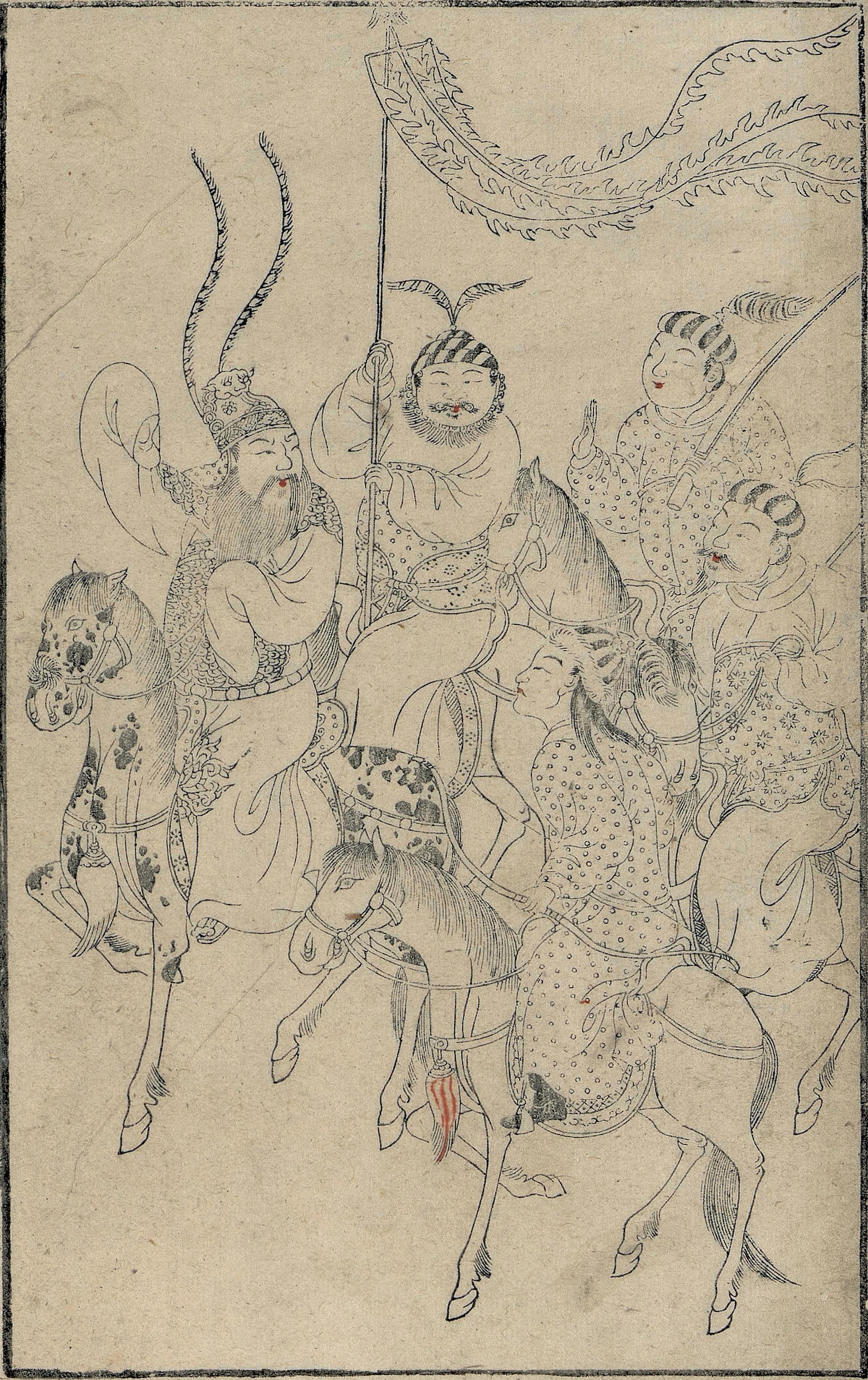
Hong Fu Ji, an engraving of Wanhuxuan in Huizhou during the Wanli period of the Ming Dynasty, collected by the National Library of China
This is also the Huxuan edition, with the title "Newly Engraved Red Fu Ji" at the front of the volume. The print is single-sided, with a slightly compact composition. It is as detailed and exquisite as Tongfang's "The Romance of the West Chamber" and "The Legend of the Pipa". Unfortunately, there is only one "volume 2" in the collection of the National Library, which is both an only copy and a fragment. Although the illustrations in "Revisiting Hongfu Ji" written by Jizhizhai in Nanjing in the 29th year of Wanli (AD 1601) are double-sided, several of them are obviously expanded and redrawn from the Wanhuxuan edition. The "Xiaoyin" in the front volume of Lingchu's "Beihongfu Zaju" mentions "the image of Ji Hua, with a big crown and a man with a beard and a person kneeling with the team", which should refer to the 34th chapter of Wanhuxuan edition "Huayi Yitang" illustration. It can be seen that this volume was written in the mid-to-late 1690s, and its influence still existed in the late Ming Dynasty.
Guanhua Xuan version of "Jade Hairpin"
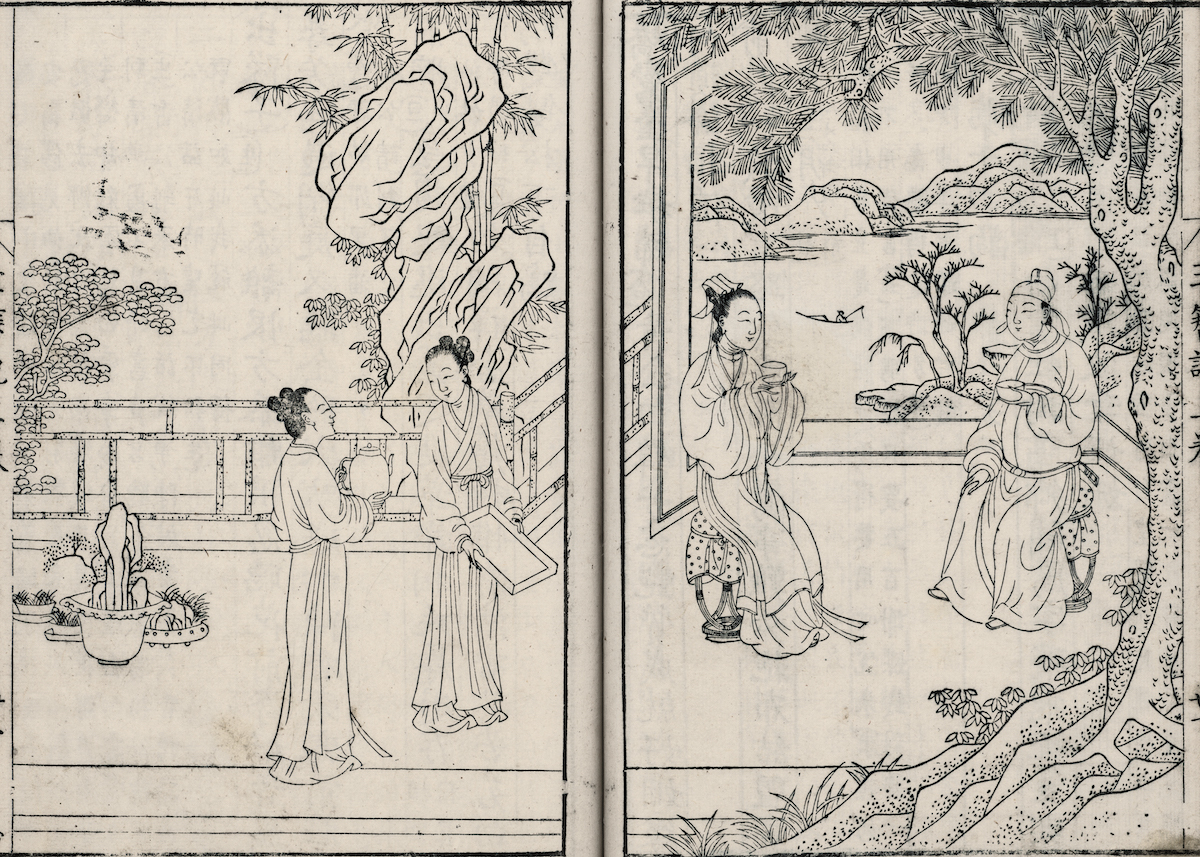
The Story of the Jade Hairpin, engraved version of Guanhuaxuan, Huizhou, in the 26th year of Wanli in the Ming Dynasty (1598 AD), collected by the Shanghai Library
The newly engraved "Jade Hairpin Notes of Privet's Reunion" by Guanhuaxuan is an only copy collected by the Shanghai Library. The two volumes are combined into one volume. The front of the volume is in order, and the first page has been damaged. The end of the text is signed "During the Ming Dynasty, Wanli, Wuxu, Mengdong and the Yuan Dynasty, Ji Muxian Sanren" "Written in Shuiyue Nunnery", followed by "Huang Jinyang Engraved", the last two pages of the book are note supplements, and the title of the volume is "Newly engraved Privet Zhenguan Chonghui Jade Hairpin Notes Shebei Xie Zixu Corrected Guanhuaxuan Chongzi", it can be seen that it is also Huizhou Produced by Bookshop.
The Guanhua Xuan version of "The Story of the Jade Hairpin" has thirteen illustrations, which are connected on both sides. The painting and engraving style is quite similar to the Wanhu Xuan version of "The Story of the Pipa" and "The Story of the West Chamber", and the era should be similar. A closer look shows that the shape is slightly slimmer than the two volumes of "Wanhuxuan", and it should be regarded as a top quality product from the beginning period of "fine-scale printmaking" in the middle Wanli period. The engraver of this volume is signed by Huang Jinyang (鍨). The Wanhuxuan version of "The Romance of the West Chamber" has the inscriptions of the engravers Huang Lian and Huang Yingyue. Nian and Liao are both the 25th generation of the Huang family in Qiu Village. They were the earliest famous artists to participate in printmaking. , the 26th "Ying Zi generation" and the 27th "Yi Zi generation" with more inscriptions in history are all their descendants. In terms of the engraving method, Guanhua Xuan's version of "The Story of the Hosta" is not inferior to the two volumes of Wanhu Xuan. If the straight and clean lines are used as the standard, it seems to have some advantages, while the smooth and flexible ones are slightly inferior. The three prints are from a similar era and region, and may have been produced by the same "team". Guanhuaxuan published "Jade Hairpin Story" in the twenty-sixth year of Wanli (AD 1598), while Wanhuxuan published "Pipa Story" " was only a year later, and it is very possible that he was inspired by the latter in his book engraving and printmaking creations. The Guanhuaxuan edition should be the ancestor of all existing editions of "Jade Hairpin". Huanyazhai, Jizhizhai and other editions all had their prints reproduced from this volume.
Jizhizhai's version of "The Romance of the West Chamber"
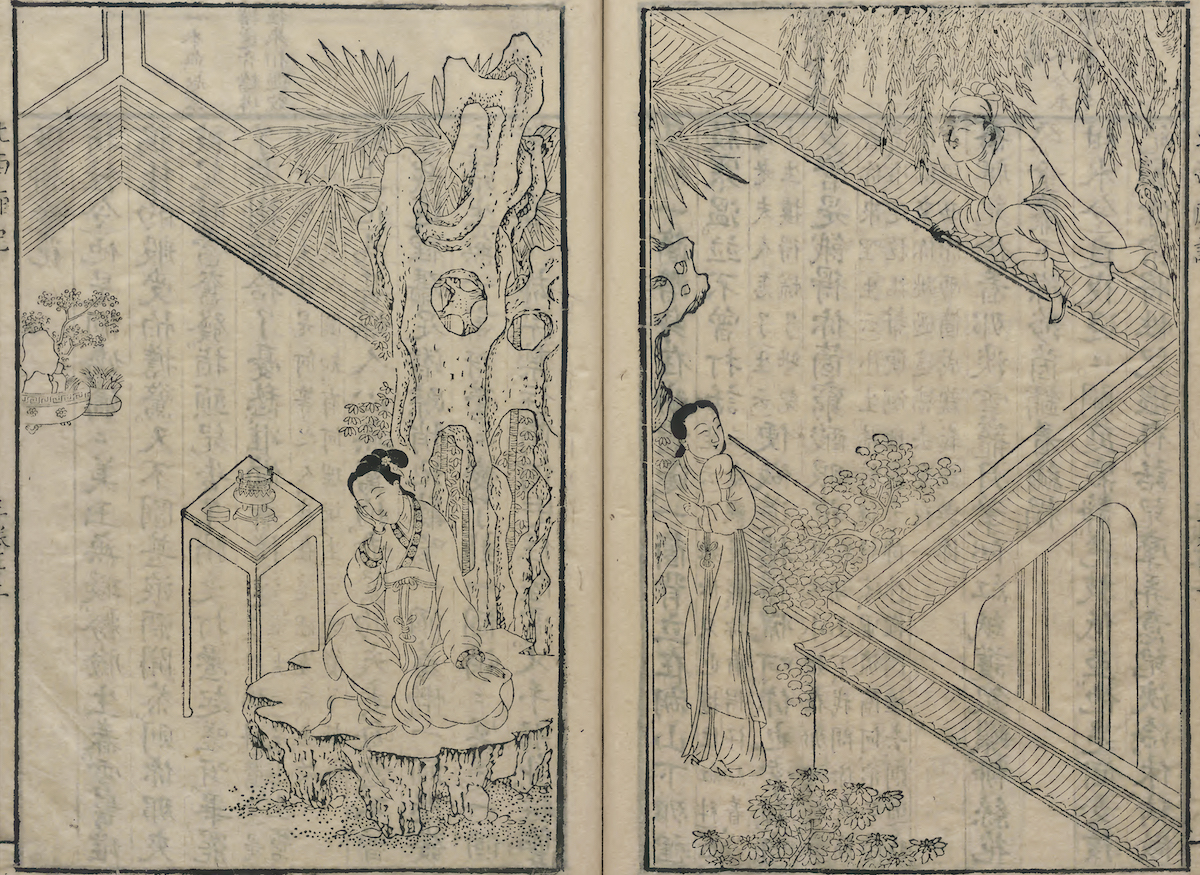
The Romance of the West Chamber, engraved version of Jizhizhai, Nanjing, in the 26th year of Wanli in the Ming Dynasty (1598 AD). [Japan] Collection of the Cabinet Library
Jizhizhai's version of "The Story of the North West Chamber" should be published jointly with Tongfang's "The Story of Pipa". The National Library of China has the Jizhizhai edition of "The Record of Chongxiao Pipa". The first volume has "Engraved Preface to the Record of Chongxiao Pipa" and the end is signed "Jiajing Wuwu Yufeng Hejian Changjun wrote Wanli Wuxu Dalai Fu Zhonglu", seal Seal two: "Da Lai" and "Chen Bangtai Seal". The Wuxu period was the twenty-sixth year of Wanli (AD 1598), which was the earliest surviving year of publication of the Jizhizhai opera. Also in the National Library, we can see "Pipa Ji" published by Wanhuxuan in the 25th year of Wanli (1597 AD). The details have been mentioned above. The illustrations in the two books are both double-sided. The Wanhuxuan edition has a total of thirty-eight pictures, nearly one for each picture, while the Jizhizhai edition has only twenty-two. The illustrations in the two books are compared with each other and the images are basically the same.
There is also a copy of Jishisai's "Pipa Chronicles" in the Japanese Cabinet Library, which is no different from the National Library Collection version. However, this book is followed by "The Story of Pipa" in four volumes and two volumes, and there is another six volumes and two volumes of "The Story of the North West Chamber". This "North and West Chamber" has a "preface to the North and West Chamber of Engraving and Correction" at the front of the volume, and is signed at the end of the volume: "Wanli Renwu Xia Longdong Mountain Farmer wrote Xie Shanqiao Yin Zhongshu and wrote it in the summer of 1898." "Longdong Shannong" is the famous scholar Jiao Hong. His version of "The Romance of the West Chamber" engraved in Renwu, Wanli (the tenth year of Wanli, 1582 AD) is very famous, but it has not been passed down. It is generally believed that Jizhizhai's version is the original version of Jizhizhai. The continuation of "Longdong Mountain's agricultural roots". According to the author's research, "Xieshan Qiaoyin" is Chen Bangtai, the owner of Jizhizhai. Next, the Jizhizhai edition also has a "Fanli" inscribed with "Moling Chen Bangtai's Collation" and a "Catalogue" titled "Wuxu Meng Xia Moling Chen Dalai's Collation". Next is a single-sided portrait of Yingying, inscribed in seal script "Yingying's photo" and signed in the lower left corner "Ming Bohu and Tang Yin wrote in Tianwang Geng". The image was copied from Gu's portrait in the third year of Longqing (1569 AD). Shi Zhongfang's study version of "Supplementary Huizhen Ji". The text contains sixteen double-sided pictures, all copied from Wan Huxuan's version of "The Romance of the North and West Chamber". They are almost identical except for very few details. Wanhuxuan carved "Pipa Ji" and "West Chamber", which were completed in the late winter of the twenty-fifth year of Wanli (AD 1597). In the past year, in the summer of the twenty-sixth year of Wanli (AD 1598), Jizhizhai has been The illustrations were reprinted, repackaged and put on the market with impressive efficiency. For example, considering that Wanhuxuan once published Jiao Hong's "Yangzheng Illustrated" and Jizhizhai's "Romance of the North and West Chamber" is also closely related to Jiao's "Longdongshan Farm Book", then this famous Nanjing scholar was behind the new trend of printmaking. The role it plays should not be underestimated.
Jizhizhai's version of "Gu Ba Yi Ji"
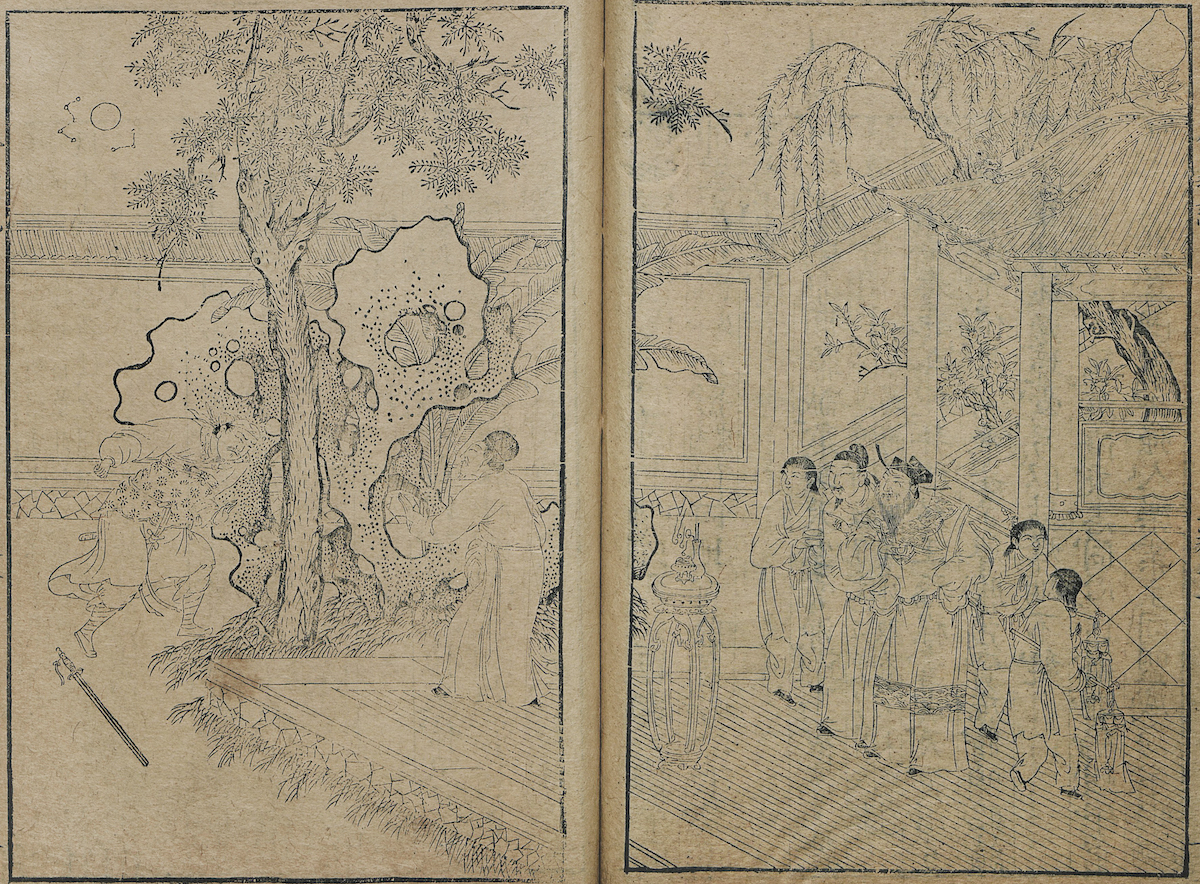
Ancient Eight Righteous Records, engraved version of Nanjing Jizhizhai in the 35th year of Wanli in the Ming Dynasty (AD 1607) [Germany] Collection of the Berlin National Library
Jizhi Zhai's copy of "Re-examination of Ancient Eight Impartments" is stored in the National Library of Berlin, Germany, and has not been known to the public for a long time. His prints seem to avoid the precision and rigor of Huifang, but they are not hasty and naive, but he attempts to create an almost elegant and free style. Similar styles are rare in Jizhizhai editions. The only ones that are similar are the illustrations of "Beigong Ci Ji" published in the 32nd year of Wanli (1604 AD). "Chongxiao Gu Ba Yi Ji" has a preface handwritten by Chen Bangtai, the owner of Jizhizhai, in the 35th year of Wanli's 35th year (AD 1607). It is a relatively recent product of this bookshop. The styles of Jizhizhai's later prints are not uniform, such as "Jin Jian Ji" and "Liang Jiang Ji" in the thirty-sixth year of Wanli (1608 AD), "Yixia Ji" in the forty year of Wanli (1612 AD), etc., illustrations The whole work was changed to one-sided, and the paintings and engravings are exquisite. However, some works were probably plagiarized from the Wenlin Pavilion of Tang's Bookstore, and the old trick of changing from double-sided to single-sided was used. At least "The Story of a Righteous Hero" is unambiguous evidence. Jizhizhai prints are mostly reprints and imitations from beginning to end. They started from learning from Huizhou to play tigers and watch various workshops. In the end, they actually took advantage of the local latecomers. Only "Beigong Ci Ji" and "Ancient Eight Meanings" The style of "Record" still has the possibility of originality, so it deserves attention.
Jizhizhai's version of "Beigong Ci Ji"
The most common extant "Beigong Ci Ji" has only one illustration in the catalog of Volume 6, which is the photocopied version of "Xu Xiu Si Ku Quanshu". Several volumes of national maps included in the collection were all written by Mr. Zheng Zhenduo. Five volumes are recorded in the "Xidi Bibliography". Among them, the volume numbered 15733 is the most complete, with six pictures, and the ones inserted in the catalog of volume one The four pictures are only visible. It may be said that the six pictures in the book should have been inserted into each volume, but this is not the case. The four pictures in Volume 1 are all engraved with "Table of Contents in Volume 1"; the pictures in Volumes 5 and 6-2 are engraved with "Table of Contents in Volume 5" and "Table of Contents in Volume 6" respectively, because each picture is known to be in the original position. Volume 1 is titled "Appreciation", and the four accompanying pictures indeed depict the social situations of scribes; Volume 5 is titled "Beauty", and Volume 6 is titled "Girlfriendship", and the pictures also depict ladies. For those who have doubts, why are there no pictures in each volume of Volumes 2, 3, and 4, which are titled "Congratulations", "Escape", and "Farewell"? In common editions, there are no pictures in the table of contents of volume one, but the page numbers are not missing. Based on this, it can be inferred that this book, like Wang Tingne's "The Complete Works of Mr. Zuiyin", has planned printing of different levels of There are different editions and illustrations, and they can be given away or sold to different recipients. Mr. Zheng’s final completed volume may not all be from the “high-end edition” of the engraver. From this point of view, there is also the possibility that volumes two, three, and four were once illustrated. I hope we can still find them in the sky. trace.

Beigong Ci Chronicles, engraved version of Jizhizhai, Nanjing, in the 32nd year of Wanli in the Ming Dynasty (1604 AD), collected by the National Library of China
The author first saw the prints of "Beigong Ci Ji" in the Harvard-Yenching Library. At that time, I didn't think they were very beautiful. Over the past few years, I have viewed them many times, and the more I looked at them, the more "unusual" they became. The style of these six-frame works is quite different from that of those who reproduced the Jizhizhai opera in the middle Wanli period or studied the works in Huizhou. This difference is mainly reflected in "painting" rather than "engraving". It can be seen that the painter of this painting is pursuing a completely different style of writing from Wang Geng. Not only the character modeling, but also the scenery, etc., although the garden scenery is chosen as much as the Wang Geng School, the expression is completely different, and the complicated and confusing decorative effect is never emphasized. This will of course also cause carvers to change their techniques. For rockery, this volume does not express the dense and dense texture like the later "Lion's Roar" by Huancui Tang and "The Romance of the West Chamber" by Qi Feng Guan. Instead, it tries its best to imitate the literati paintings. Chasing effect. "Beigong Ci Ji" was published in the 32nd year of Wanli (AD 1604). Previously, Wang Geng's school represented by Wanhuxuan and Guanhuaxuan Quben prints had been popular for several years, and through Jizhizhai's reprints, The imitation system spread to Nanjing. After that, the Huancui Hall and Qifeng Hall systems intensified their pursuit of decorative effects and complicated engravings, reaching their peak. What will be popular in future generations will be the illustrations of small landscapes in landscape gardens. . The style attempted in this volume seems to have few successors. Among the works in Ji Zhi Zhai, only the "Chongxiao Gu Ba Yi Ji" has a slightly different charm and many standards are inferior.
(The author of this article is a professor at the China Academy of Art. The full text is excerpted from the article "Zaoli Gongfang Miscellanies" published by the "Master Craftsman's Gate" of the Beijing Academy of Fine Arts.)
